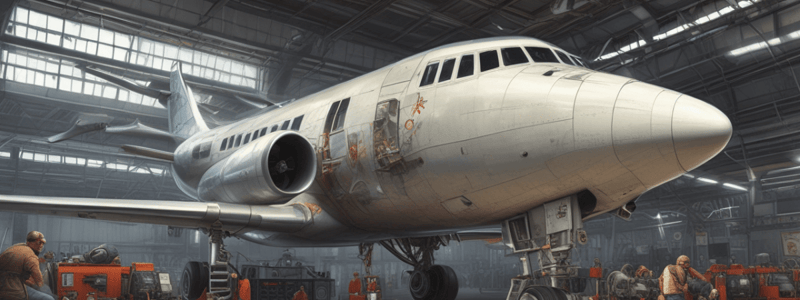Podcast
Questions and Answers
Why is a thorough inspection of the exhaust system necessary?
Why is a thorough inspection of the exhaust system necessary?
- Because it is a routine maintenance task
- Because it is a regulatory requirement
- Because the cabin heating system uses air heated by the heat exchangers of the exhaust system (correct)
- Because it is only done every 500-hours of operation
What is a common issue with exhaust systems of this type?
What is a common issue with exhaust systems of this type?
- Electrical faults
- Oil leaks
- Corrosion from moisture
- Burning, cracking, and general deterioration (correct)
How often should the exhaust system be inspected?
How often should the exhaust system be inspected?
- Every 50-hours of operation
- Every 200-hours of operation
- Every 100-hours of operation (correct)
- Every 500-hours of operation
When should an additional inspection of the exhaust system be performed?
When should an additional inspection of the exhaust system be performed?
What is a consequence of not inspecting the exhaust system regularly?
What is a consequence of not inspecting the exhaust system regularly?
What is the purpose of the suction screen in the sump pickup tube?
What is the purpose of the suction screen in the sump pickup tube?
What is the function of the oil pressure relief valve?
What is the function of the oil pressure relief valve?
Which component is responsible for pressurizing the oil in the system?
Which component is responsible for pressurizing the oil in the system?
Where does the oil flow after passing through the oil cooler?
Where does the oil flow after passing through the oil cooler?
What is the purpose of the galleries in the oil system?
What is the purpose of the galleries in the oil system?
Flashcards are hidden until you start studying
Study Notes
Exhaust System Inspection
- The exhaust system must be thoroughly inspected due to its connection to the cabin heating system, which uses air heated by the heat exchangers of the exhaust system.
- Exhaust systems of this type are prone to damage from thermal stresses and vibration, leading to burning, cracking, and general deterioration.
- Inspections should be conducted every 100 hours of operation to ensure safety.
- Additional inspections are required if exhaust fumes are detected in the cabin area.
Oil System Overview
- The O-200-A series engines use a wet-sump, pressure-lubricating oil system.
Oil Flow Path
- Oil in the sump passes through the sump pickup tube and suction screen to the oil pump's suction side.
- From the oil pump's pressure side, oil is fed through the pressure oil screen or external full-flow oil filter into the left oil gallery.
- If an oil cooler is installed, oil flows through the oil cooler bypass valve, then to the cooler via a flexible hose connection, and back to the engine via a second flexible hose connection.
Oil Distribution
- Oil flows forward through the left gallery, across the crankcase, and into the right gallery through passages connected by the camshaft front journal groove.
- The right gallery is closed by the oil pressure relief valve at its rear end.
- The galleries pressure-feed the main bearings, camshaft bearings, and hydraulic tappets.
Studying That Suits You
Use AI to generate personalized quizzes and flashcards to suit your learning preferences.




